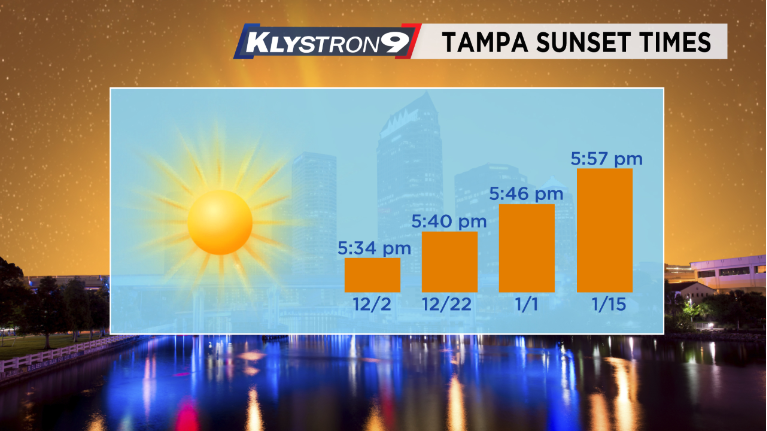The shortest day of the year in terms of daylight occurs on the winter solstice but that is not when Tampa observes its earliest sunset. In fact, the earliest sunset occurs during the first few days of December-- setting at 5:34 PM.
While that may seem like an early sunset, it doesn't even compare to other cities around the country. Try living in Chicago where the earliest sunset occurs on December 8 at 4:19 p.m. or Boston with a 4:11 p.m. sunset.
If you think those sunsets are brutal, check out Caribou, Maine...home to one of the earliest sunsets in the lower 48 -- setting at 3:43 in the afternoon! December 10 is when Caribou, Maine observes its earliest sunset of the year. The northern latitude and its location on the eastern edge of the Eastern Time Zone makes Caribou home to one of the earliest sunsets of the year.
Some may not realize that Caribou shares a similar sunset time as Anchorage, Alaska this time of year. Anchorage's earliest sunset occurs on December 17 at 3:40 p.m., just 3 minutes earlier than Caribou's.
Fairbanks, which sits 360 miles north of Anchorage, observes its earliest sunset on December 18 at 2:39 in the afternoon!
If you prefer dark days then Utqiagvik, formerly known as Barrow, Alaska, doesn't even get a sunrise this time of year. In fact, the sun will not rise in Utqiagvik until January 23 when the sun rises at 1:04 p.m. and sets just an hour later at 2:14 p.m.

So why does Tampa's earliest sunset not fall on the winter solstice?
It has to do with a few factors such as the concept of the 24 hour day and our latitude.
Tampa's latitude plays a big role here. Cities near the equator see their earliest sunset sometime in November. The date of the earliest sunset gets closer to the winter solstice the further north you go. This happens because of the angle of the sun's rays over the Earth's equator. This angle varies through the year due to the 23.4 degree tilt of the planet on its axis.
The other factor affecting the date of Tampa's earliest sunset is our day length. Did you know a true solar day isn't exactly 24 hours long? The length of a solar day varies through the year because of the planet's elliptical path around the sun. A solar day is longer than 24 hours around the winter and summer solstice and shorter than 24 hours during the vernal and autumnal equinoxes. This means solar noon and clock noon do not match up exactly through the year.
As a result, the earliest sunset occurs before the winter solstice and the latest sunrise occurs after the winter solstice.



